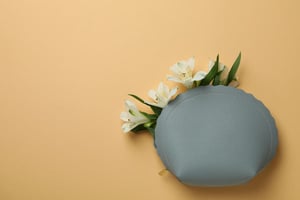5 min read Soundwave Hearing suggests accessories to pair with our SONTRO® OTC Hearing Aids....
Say Goodbye to Dirt and Grime: A Step-by-Step Guide on How to Clean Your Hearing Aid Domes and Devices
By: Anthony Florek, President and Founder, Soundwave Hearing
Anthony brings 15 years of experience from the traditional hearing aid industry and leads the development of the business model and value proposition at Soundwave Hearing.
It is important to keep the ear domes clean to help you hear your best.
Earwax is funny; everyone’s ears produce a different amount of earwax. A buildup of earwax on your hearing aid ear domes can cause you not to hear your best. As you wear your hearing aids for more time during the day, you will begin to notice the rhythm of wax production and how often you will need to clean your hearing aid ear domes.
Now, let's delve into why regular cleaning of both your hearing aid ear domes and devices is imperative for maintaining their functionality.
Why Should I Clean My Hearing Aid Ear Domes?
The inside of your ears is a sweaty place. When you wear your hearing aids, ear domes collect earwax and hold onto the moisture in your ear. This moisture and earwax buildup can affect your hearing aid’s performance. Thus, cleaning hearing aid domes regularly is essential.
How to Clean Hearing Aid Domes
Hearing aid ear domes are best cleaned using a cleaning brush with a wax loop on the opposite end and audio wipes. Always brush your hearing aid ear domes facing down with the brush facing up under the ear dome so the wax falls out when brushing. Use the wax loop to loosen the wax in the center of the ear dome.
The audio wipes are moist and can remove excess earwax from the ear dome, receiver, and hearing aid itself. In addition, Soundwave offers a video on Ear Dome Cleaning and Wax Guard Removal so you can practice and learn the best way to clean hearing aids.
Hearing Aid Ear Dome Cleaning Best Practices
Here are a few best practices for safely caring for and cleaning your hearing aid ear domes:
- Develop a routine to clean and inspect your hearing aid ear domes. Avoid storing the ear domes in extreme heat or cold temperatures.
- As a general rule of thumb, it’s a good idea to wash your hands before cleaning your hearing aids to make sure you don’t transfer any bacteria onto your devices. Use a clean counter when cleaning or changing the hearing aid ear domes.
- If you notice that the hearing aid ear dome is torn or damaged, dispose of it and replace it with a new one. New hearing aid ear domes may be purchased in packages of 10 on Soundwave’s accessory page.
Now that you're equipped with ear dome cleaning techniques let's explore best practices for overall hearing aid maintenance to extend device lifespan and optimize performance.
How Often Should I Clean My Hearing Aids?
Ear wax builds up more quickly when you first start using hearing aids, so it’s important to clean them daily and weekly.
Daily Hearing Aids Cleaning Maintenance:
Every day, pick a time to do some brief hearing aid cleaning. Remove the hearing aid from your ear before you begin cleaning. Brush the microphone softly to dislodge any wax or dirt. Then, wipe down the hearing aid with a soft, dry cloth or a non-alcohol wipe. Doing this every day will prevent the need to spend longer cleaning your hearing aid in your weekly cleaning. Consider cleaning this in the evenings so the hearing aid will dry out overnight before reinsertion.
Weekly Hearing Aids Cleaning Maintenance:
Pick a day and time to do a more thorough hearing aid cleaning every week. At this time, you can use your wax pick to focus on removing any stubborn wax or debris that built up throughout the week and wasn’t easily removed during your daily cleaning. Turn the hearing aid upside down while cleaning to ensure that any wax and debris will fall out instead of into your hearing aid. If your hearing aid has a wax guard, make sure to change your wax guard regularly, too.
Ensuring Hearing Aid Wax Guards Are Replaced Properly
Seeing as wax build-up has such an impact on your hearing aids; it is crucial to keep them protected with wax guards. Cerustop Wax Guards for the Sontro OTC Hearing Aids can be found on Amazon. Wax guards protect your hearing device and should be changed at least once per month. Let’s review how to replace your wax guard:
- Remove your ear dome from the receiver first
- Insert the pick end of the removal tool into the opening of the wax guard on the receiver
- Pull gently to remove the used wax guard
- Using the opposite side of the removal tool, place the new tip into the receiver
- Extract the removal tool and discard
- Press the new dome for your hearing aid over the receiver using your thumb and forefinger
Things to Avoid When Cleaning Your Hearing Aids
OTC hearing aids are delicate devices and should be cleaned with care. That being said, you should avoid the following:
- Never use water on your hearing device because this could damage the intrinsic electronics
- Never use harsh chemicals or cleaners on your hearing aid or anything that isn’t designed for hearing aid cleaning
- Never put anything into the receiving ports, and be careful not to jam wax and debris into the open receiver or microphone
These actions are considered unsafe for hearing aids and should be avoided so your hearing aid stays in its best shape. If you’re not sure if something is hearing aid safe, consult your user manual before continuing.
Cleaning your hearing aid, ear domes, and devices is as important as bathing and washing your clothes, dishes, and sheets. It’s crucial to develop a routine based on your ears and the amount of wax deposited in the hearing aid ear domes to maintain the quality of your Sontro® Self-Fitting OTC Hearing Aids.



